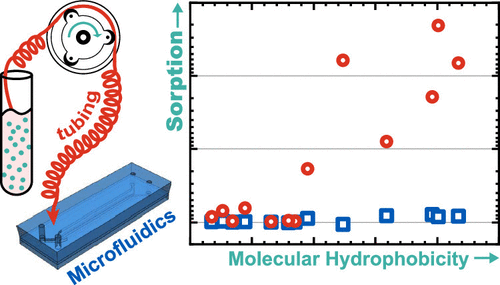当前位置:
X-MOL 学术
›
ACS Appl. Mater. Interfaces
›
论文详情
Our official English website, www.x-mol.net, welcomes your
feedback! (Note: you will need to create a separate account there.)
Sorption of Neuropsychopharmaca in Microfluidic Materials for In Vitro Studies
ACS Applied Materials & Interfaces ( IF 8.3 ) Pub Date : 2021-09-16 , DOI: 10.1021/acsami.1c07639 Thomas E Winkler 1 , Anna Herland 1, 2
ACS Applied Materials & Interfaces ( IF 8.3 ) Pub Date : 2021-09-16 , DOI: 10.1021/acsami.1c07639 Thomas E Winkler 1 , Anna Herland 1, 2
Affiliation

|
Sorption (i.e., adsorption and absorption) of small-molecule compounds to polydimethylsiloxane (PDMS) is a widely acknowledged phenomenon. However, studies to date have largely been conducted under atypical conditions for microfluidic applications (lack of perfusion, lack of biological fluids, etc.), especially considering biological studies such as organs-on-chips where small-molecule sorption poses the largest concern. Here, we present an in-depth study of small-molecule sorption under relevant conditions for microphysiological systems, focusing on a standard geometry for biological barrier studies that find application in pharmacokinetics. We specifically assess the sorption of a broad compound panel including 15 neuropsychopharmaca at in vivo concentration levels. We consider devices constructed from PDMS as well as two material alternatives (off-stoichiometry thiol–ene–epoxy, or tape/polycarbonate laminates). Moreover, we study the much neglected impact of peristaltic pump tubing, an essential component of the recirculating systems required to achieve in vivo-like perfusion shear stresses. We find that the choice of the device material does not have a significant impact on the sorption behavior in our barrier-on-chip-type system. Our PDMS observations in particular suggest that excessive compound sorption observed in prior studies is not sufficiently described by compound hydrophobicity or other suggested predictors. Critically, we show that sorption by peristaltic tubing, including the commonly utilized PharMed BPT, dominates over device sorption even on an area-normalized basis, let alone at the typically much larger tubing surface areas. Our findings highlight the importance of validating compound dosages in organ-on-chip studies, as well as the need for considering tubing materials with equal or higher care than device materials.
中文翻译:

用于体外研究的微流体材料中神经精神药物的吸附
小分子化合物对聚二甲基硅氧烷(PDMS)的吸附(即吸附和吸收)是一种广泛公认的现象。然而,迄今为止的研究大部分是在微流体应用的非典型条件下进行的(缺乏灌注、缺乏生物液体等),特别是考虑到小分子吸附引起最大关注的诸如器官芯片等生物学研究。在这里,我们对微生理系统相关条件下的小分子吸附进行了深入研究,重点关注在药代动力学中应用的生物屏障研究的标准几何结构。我们专门评估了包括 15 种神经精神药物在内的广泛化合物组在体内浓度水平的吸附情况。我们考虑使用 PDMS 以及两种材料替代品(非化学计量的硫醇-烯-环氧树脂或胶带/聚碳酸酯层压材料)构建的设备。此外,我们研究了蠕动泵管被忽视的影响,蠕动泵管是实现体内类似灌注剪切应力所需的再循环系统的重要组成部分。我们发现,器件材料的选择对我们的片上屏障型系统的吸附行为没有显着影响。我们的 PDMS 观察结果特别表明,化合物疏水性或其他建议的预测因子不足以描述先前研究中观察到的过度化合物吸附。重要的是,我们表明,即使在面积归一化的基础上,蠕动管(包括常用的 PharMed BPT)的吸附也比装置吸附占主导地位,更不用说在通常更大的管道表面积上。 我们的研究结果强调了在器官芯片研究中验证化合物剂量的重要性,以及需要以与设备材料同等或更高的谨慎程度考虑管道材料。
更新日期:2021-09-29
中文翻译:

用于体外研究的微流体材料中神经精神药物的吸附
小分子化合物对聚二甲基硅氧烷(PDMS)的吸附(即吸附和吸收)是一种广泛公认的现象。然而,迄今为止的研究大部分是在微流体应用的非典型条件下进行的(缺乏灌注、缺乏生物液体等),特别是考虑到小分子吸附引起最大关注的诸如器官芯片等生物学研究。在这里,我们对微生理系统相关条件下的小分子吸附进行了深入研究,重点关注在药代动力学中应用的生物屏障研究的标准几何结构。我们专门评估了包括 15 种神经精神药物在内的广泛化合物组在体内浓度水平的吸附情况。我们考虑使用 PDMS 以及两种材料替代品(非化学计量的硫醇-烯-环氧树脂或胶带/聚碳酸酯层压材料)构建的设备。此外,我们研究了蠕动泵管被忽视的影响,蠕动泵管是实现体内类似灌注剪切应力所需的再循环系统的重要组成部分。我们发现,器件材料的选择对我们的片上屏障型系统的吸附行为没有显着影响。我们的 PDMS 观察结果特别表明,化合物疏水性或其他建议的预测因子不足以描述先前研究中观察到的过度化合物吸附。重要的是,我们表明,即使在面积归一化的基础上,蠕动管(包括常用的 PharMed BPT)的吸附也比装置吸附占主导地位,更不用说在通常更大的管道表面积上。 我们的研究结果强调了在器官芯片研究中验证化合物剂量的重要性,以及需要以与设备材料同等或更高的谨慎程度考虑管道材料。











































 京公网安备 11010802027423号
京公网安备 11010802027423号